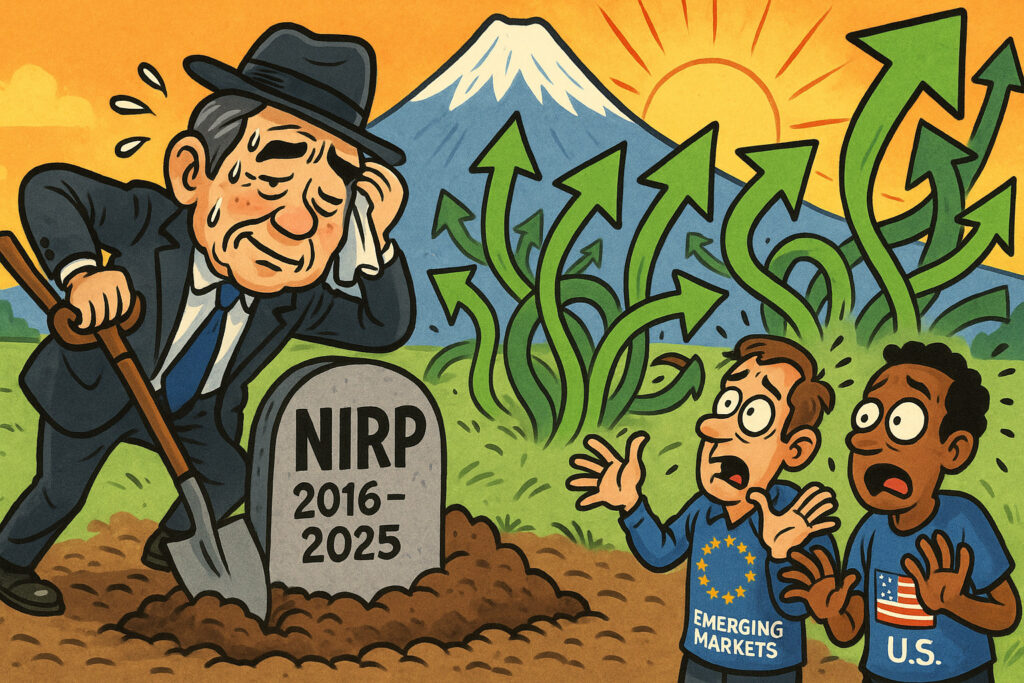Japan’s Historic Shift: End of Negative Rates After Nearly a Decade
On April 15, 2025, the Bank of Japan (BoJ) made a landmark decision that reverberated through global financial markets: it officially ended its negative interest rate policy (NIRP). After maintaining negative rates since early 2016 to stimulate inflation and economic growth, the BoJ raised its benchmark short-term rate to 0.10%. This long-awaited move, signaling a return to “normal” monetary policy, sent shockwaves through bond markets, currency markets, and equity indices worldwide.
Governor Kazuo Ueda announced the decision following the BoJ’s policy meeting, citing “sustained inflation around the 2% target” and “steady improvements in wage growth and domestic consumption” as primary reasons for the historic policy pivot.
Immediate Market Reaction
Japanese Yen Strengthens
The Japanese yen (JPY) surged sharply in response. As of midday trading on April 15:
- USD/JPY: ↓ 2.1% to 144.50
- EUR/JPY: ↓ 1.8% to 154.20
The yen’s strength reflects the unwinding of carry trades and rising investor confidence in Japan’s economic fundamentals.
Global Bond Yields Spike
Government bond yields across major economies climbed sharply:
- Japanese 10-year JGB yield: ↑ 0.52% (up from 0.35%)
- U.S. 10-year Treasury yield: ↑ 9 bps to 4.45%
- German 10-year Bund yield: ↑ 7 bps to 2.78%
The rise in yields reflects expectations that global central banks may also face renewed pressure to maintain tighter monetary conditions.
Equity Markets Volatile
Asian equity markets closed mixed, while European and U.S. futures pointed lower initially before stabilizing. Major indices movements as of close:
- Nikkei 225: ↓ 1.7% to 38,150
- Topix: ↓ 1.2% to 2,715
- Euro Stoxx 50: ↓ 0.5%
- S&P 500 Futures: → flat around 5,130
Investors recalibrated positions across sectors most sensitive to borrowing costs and currency volatility.
Economic Context Behind the BoJ Decision
The BoJ’s negative rate policy, part of its ultra-loose monetary framework alongside massive asset purchases and yield curve control (YCC), was implemented to combat persistent deflation. Over nearly a decade, Japan battled stagnant prices, sluggish wage growth, and an aging population.
However, several structural shifts in recent years made today’s decision possible:
- Inflation: Core inflation remained above 2% for 20 consecutive months.
- Wages: Major corporations agreed to the largest wage hikes in 30 years during the annual “shunto” spring labor negotiations.
- Consumption: Consumer spending recovered robustly post-pandemic, despite demographic headwinds.
Governor Ueda emphasized that “the BoJ will continue to monitor conditions closely and adjust policy gradually,” suggesting a cautious normalization path.
Global Implications of Japan’s Move
1. Higher Global Borrowing Costs
Japan’s exit from negative rates removes a major source of ultra-cheap capital globally. Japanese institutional investors — historically heavy buyers of foreign bonds due to meager domestic returns — may now reallocate funds back home, pressuring overseas bond markets.
2. Currency Rebalancing
Stronger yen could diminish the competitiveness of Japanese exporters while boosting Japanese imports. At the same time, emerging markets could feel strain from a rebounding yen and firmer U.S. dollar amid shifting capital flows.
3. Central Bank Policy Divergence
While the BoJ tightens, other central banks such as the Federal Reserve and ECB are grappling with disinflation trends. Divergent monetary paths could heighten currency volatility and complicate multinational corporate earnings.
4. Equity Sector Rotations
Higher yields may prompt sectoral shifts away from high-duration assets (e.g., tech stocks) toward value-oriented sectors such as financials, which typically benefit from rising rates.
Analyst Commentary
Nomura Chief Economist Takashi Miwa:
“This is a defining moment for Japan. Ending negative rates signals confidence in the domestic economy’s resilience. However, the BoJ must tread carefully to avoid derailing growth momentum.”
Goldman Sachs Head of Fixed Income Research Kristina Hooper:
“Japanese investors repatriating funds could spark a broad repricing of global bonds. Duration risk is back in focus for fixed income portfolios.”
Forward-Looking Scenarios
Best-Case Scenario
- Japan’s inflation stabilizes at target levels.
- Wage growth sustains consumption.
- BoJ normalizes gradually, avoiding market disruptions.
- Global yield adjustments occur in an orderly fashion.
Worst-Case Scenario
- Inflation undershoots, forcing a policy reversal.
- Yen appreciation hurts exports significantly.
- Global bond selloff triggers broader risk-off sentiment.
Key Asset Updates (April 15, 2025)
- USD/JPY: 144.50
- EUR/JPY: 154.20
- Nikkei 225: 38,150
- Topix: 2,715
- JGB 10Y yield: 0.52%
- U.S. 10Y Treasury yield: 4.45%
- Brent Crude: $88.40/barrel (unchanged)
- Gold: $2,310/oz (+0.8%)
Conclusion
Japan’s historic decision to end its negative rates era marks a profound shift not only for the country but also for global financial markets. As bond yields adjust and currency markets recalibrate, investors must navigate a landscape reshaped by this pivotal moment. While the BoJ’s cautious tone suggests a gradual normalization, the ripple effects across asset classes and geographies are already unfolding.
The world’s third-largest economy has entered a new phase—and so have global markets.
